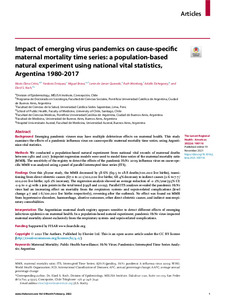Por favor, use este identificador para citar o enlazar este ítem:
https://repositorio.uca.edu.ar/handle/123456789/14316| Título: | Impact of emerging virus pandemics on cause-specific maternal mortality time series: a population-based natural experiment using national vital statistics, Argentina 1980-2017 | Autor: | Critto, María Elena Enríquez, Yordanis Bravo, Miguel De Janon Quevedo, Lenin Weinbergf, Ruth Etchegaray, Adolfo Koch, Elard S. |
Palabras clave: | MORTALIDAD MATERNA; VIRUS DE LA INFLUENZA PORCINA; SALUD PUBLICA; VIRUS A-H1 N1; PANDEMIA | Fecha de publicación: | 2022 | Editorial: | Elsevier | Cita: | Critto, M.E., et al. Impact of emerging virus pandemics on cause-specific maternal mortality time series: a population-based natural experiment using national vital statistics, Argentina 1980-2017 [en línea]. The Lancet Regional Health - Americas. 2022, 6 doi:10.1016/j.lana.2021.100116 Disponible en: https://repositorio.uca.edu.ar/handle/123456789/14316 | Resumen: | Abstract: Abstract
Background Emerging pandemic viruses may have multiple deleterious effects on maternal health. This study
examines the effects of a pandemic influenza virus on cause-specific maternal mortality time series, using Argentinian vital statistics.
Methods We conducted a population-based natural experiment from national vital records of maternal deaths
between 1980 and 2017. Joinpoint regression models were used to model time series of the maternal mortality ratio
(MMR). The sensitivity of the registry to detect the effects of the pandemic H1N1 2009 influenza virus on cause-specific MMR was analysed using a panel of parallel interrupted time series (ITS).
Findings Over this 38-year study, the MMR decreased by 58¢6% (69¢5 to 28¢8 deaths/100,000 live births), transitioning from direct obstetric causes (67¢0 to 21¢1/100,000 live births; 68¢4% decrease) to indirect causes (2¢6 to 7¢7/
100,000 live births; 196¢2% increase). The regression analysis showed an average reduction of -2¢2%/year (95% CI:
-2¢9 to -1¢4) with 2 join points in the total trend (1998 and 2009). Parallel ITS analyses revealed the pandemic H1N1
virus had an increasing effect on mortality from the respiratory system- and sepsis-related complications (level
change 4¢7 and 1¢6/100,000 live births respectively), reversing after the outbreak. No effect was found on MMR
from hypertensive disorders, haemorrhage, abortive outcomes, other direct obstetric causes, and indirect non-respiratory comorbidities.
Interpretation The Argentinian maternal death registry appears sensitive to detect different effects of emerging
infectious epidemics on maternal health. In a population-based natural experiment, pandemic H1N1 virus impacted
maternal mortality almost exclusively from the respiratory system- and sepsis-related complications. Supplementary material associated with this article can be found, in the online version, at doi:10.1016/j.lana.2021.100116 Resumen: Antecedentes: Los virus pandémicos emergentes pueden tener múltiples efectos nocivos sobre la salud materna. Este estudio examina los efectos de un virus de influenza pandémica mediante series de tiempo ininterrumpidas de mortalidad materna por causas específicas, utilizando estadísticas vitales argentinas. Métodos: Realizamos un experimento natural con base poblacional a partir de registros vitales nacionales de muertes maternas entre 1980 y 2017. Se utilizaron modelos de regresión con punto de unión para modelar series de tiempo de la razón de mortalidad materna (RMM). La sensibilidad del registro para detectar los efectos del virus de la influenza pandémica A H1N1 2009 sobre las causas específicas de la RMM se analizó mediante un panel de series de tiempo interrumpidas (STI). Hallazgos: Durante este estudio de 38 años, la RMM disminuyó en un 58·6% (69·5 a 28·8 muertes/100.000 nacidos vivos), pasando de causas obstétricas directas (67·0 a 21·1/100.000 nacidos vivos; 68·4% de disminución) a causas indirectas (2·6 a 7·7/100.000 nacidos vivos; 196·2% de aumento). El análisis de regresión mostró una reducción promedio de -2·2%/año (IC 95%: -2·9 a -1·4) con 2 puntos de inflexión en la tendencia total (1998 y 2009). Los análisis de STI revelaron que el virus pandémico A H1N1 tuvo un efecto creciente sobre la mortalidad por complicaciones del sistema respiratorio y relacionadas con la sepsis (cambio de nivel 4·7 y 1·6/100.000 nacidos vivos, respectivamente), revirtiéndose después del brote. No se encontró ningún efecto sobre la RMM por trastornos hipertensivos, hemorragia, desenlace abortivo, otras causas obstétricas directas y comorbilidades indirectas no respiratorias. Interpretación: El registro de defunciones maternas de Argentina parece sensible para detectar diferentes efectos de las epidemias infecciosas emergentes sobre la salud materna. En el experimento natural poblacional, el virus pandémico A H1N1 afectó la mortalidad materna casi exclusivamente por complicaciones relacionadas con el sistema respiratorio y la sepsis. |
URI: | https://repositorio.uca.edu.ar/handle/123456789/14316 | ISSN: | 2667-193X | Disciplina: | MEDICINA | DOI: | 10.1016/j.lana.2021.100116 | Derechos: | Acceso abierto | Fuente: | The Lancet Regional Health - Americas |
| Aparece en las colecciones: | Artículos |
Ficheros en este ítem:
| Fichero | Descripción | Tamaño | Formato | |
|---|---|---|---|---|
| impact-emerging-virus-pandemics.pdf | 461,77 kB | Adobe PDF |  Visualizar/Abrir | |
| SupplementaryMaterial.zip | Material Suplementario | 166,5 kB | ZIP | Visualizar/Abrir |
Visualizaciones de página(s)
69
comprobado en 27-abr-2024
Descarga(s)
54
comprobado en 27-abr-2024
Google ScholarTM
Ver en Google Scholar
Altmetric
Altmetric
Este ítem está sujeto a una Licencia Creative Commons

